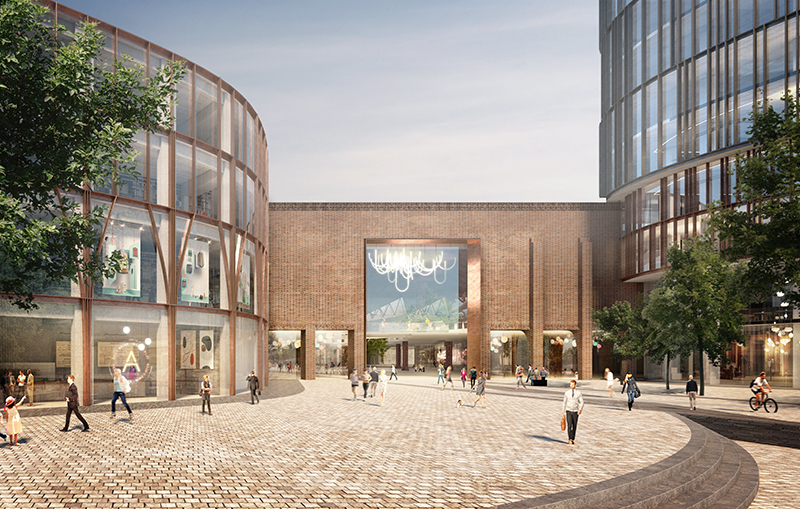Project showcase
The Depot, Bucharest - KAP Studios

This city-scale £500m project will transform disused railway lands and old warehouses into a new neighbourhood with a mix of homes, shopping, offices, a music venue, hotels, healthcare and education
Who is the developer/client of the project?
Griro
Describe the context of this project.
The Depot will offer a vibrant new city quarter for Bucharest that adapts striking railway buildings, and their yard spaces to create a new energetic, and community-driven district that celebrates urban living.
At a size of 400,000 sqm, this city-scale, £500 million project is located in central Bucharest, and will transform disused railway lands and old warehouses into a vibrant new neighbourhood. Here, an engaging mix of homes, shopping, offices, a music venue, hotels, healthcare, and education will both foster a new community as well as attract visitors, for economic sustainability.
Please describe your approach to this future place and its mix of uses. How will it function as a vibrant place? How does it knit into, and serve the needs of, the wider area?
The Bucharest Depot was once used to dismantle steam locomotives, and a collection of large warehouses remain; their height and scale a nostalgic reminder of their industrial past.
Rather than demolish the existing buildings, our client sought to retain and celebrate the site’s rich history. An unusual approach in Bucharest where demolition and clean slates are preferred, we have worked with our client to nurture the historic character and extend the best of the existing buildings, while adding new buildings around the perimeter to create a lively quarter with a blend of exciting uses in the city centre.
A series of buildings invite you to enter the site via a new public space adjacent to the local metro station. Flanked by two new office buildings which mark the ends of the site, the largest warehouse offers a retail experience that brings together affordable space for local makers and iconic Romanian produce alongside recognised international brands. On the far side of the warehouse, a series of open spaces and gardens form the setting for a new school, health centre, hotels, and residential buildings. Traffic is pushed towards a new perimeter road and frees up all the public spaces for pedestrian access, cyclists, and last-mile electric transit. The future of Bucharest is yet to be written, but it is projects like this that will ensure it will create its own unique take on 21st century urbanism, viewed through a creatively critical lens.
How will the carbon use/material impact of the development of this new place be mitigated? What is the sustainability strategy?
Maximising the opportunities inherent in the existing structure of the Bucharest Depot is at the core of our design strategy and one that allows the fabric of the building to be recycled as part of an approach to the circular economy that exemplifies sustainable re-use. Demolition is minimised, instead retaining the building forms of the historic depot to create a distinctive landmark in modern Bucharest.
Understanding that the carbon released during demolition will take 30+ years to repay each element of the structures currently occupying the site has been carefully audited and where possible repaired and re-used in-situ. Where demolition is unavoidable all key materials – such as the distinctive facing bricks that clad the existing structures on site – have been re-used as part of new structures that blend harmoniously with the historic fabric of the site.
Biodiversity, across extensive roof gardens, creates a new habitat for species across the site allowing green roofs and fauna to sequester carbon and attenuate rainfall. Careful block positioning where vertical extension has taken place ensures high levels of natural daylight and the ability to naturally ventilate the office and residential spaces that occupy the higher floors of the development.
Open spaces promote wellness and connectivity on a large site that was formerly isolated from its surroundings by heavy infrastructure. Active edges and a diverse programme ensure that the site is active, welcoming and socially sustainable.
What do you see as the greatest contribution of this project to the citizens of this future place and its surrounding areas? You may also attach an additional image or document to support your entry.
"A city district that celebrates heritage, craftsmanship, and urban living, the scheme offers a rich mix of workspace, entertainment, retail, residential, hospitality, and public spaces that have been designed to revitalise an industrial site in the city centre. The masterplan integrates modern buildings into these old structures and spaces to create a distinctive new city district.
A new path weaves through a new ‘Ground Level’ on top of the existing warehouses. It gives access to the office and residential buildings that line this new public space by connecting existing roof spaces with tennis courts, food markets and promenades. An entertainment complex is housed at the Northwest end of the site, acting as an anchor to draw residents and visitors through the retail spaces of the ground floor warehouses through to a music venue and landscaped gardens.
Buildings open up in the summer, to reveal outdoor amphitheatres and stage spaces. Two new landmark office towers are positioned at the ends of the site helping delineate its boundaries and acting as wayfinders within the complex and beacons for the wider city. Between the towers, a range of office, retail, hospitality and leisure uses open up to public squares and covered spaces.
Parking is intelligently managed over a 24-hour cycle, with office workers by day giving way to those visiting bars and entertainment venues at night. All vehicle traffic is pushed out to a new perimeter road allowing the heart of the project to remain pleasantly car-free for families, flaneurs, and cyclists alike."
Festival of Pineapples
24-26 February 2026
Pineapples prize giving night
April
Pineapples at Festival of Place
10 June 2026
© The Pineapples - Tweak Ltd. 124 City Road, London, EC1V 2NX. Tel: 020 3326 7238




